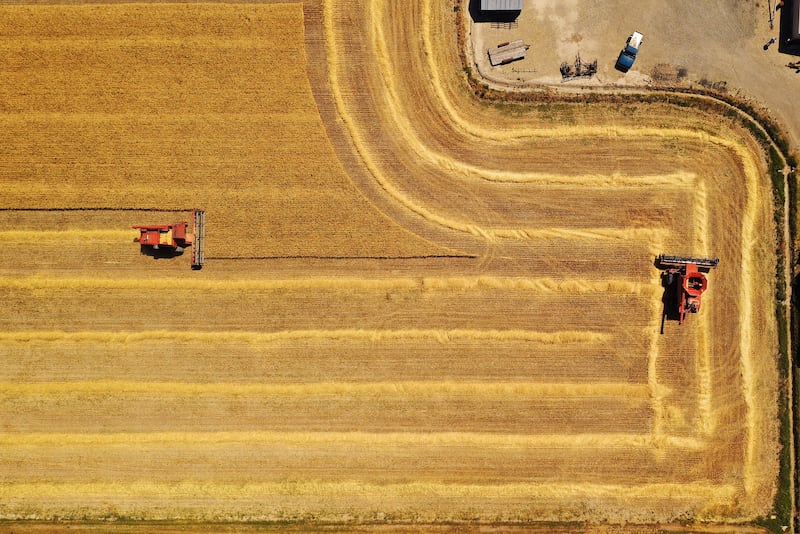TREMONTON — For the Nathan Hege family and many other farmers along the Wasatch Front, the harvest season spans from late July to late August.
Last week Hege, a farmer and bishop of the Northern Utah Mennonite Church, watched as his sons operated two red combines in a neighbor’s wheat field. Vernon Hege, accompanied by his 3-year-old son Leroy, drove one thrashing machine while 13-year-old Adrian Hege steered the other harvester. When each bin was full, the brothers took turns dumping grain into semitrailer parked nearby.
When asked what he enjoyed most about the annual harvest, Bishop Hege smiled and laughed.
“Getting finished,” he said.
While some of his crops have struggled this year, the bishop is grateful for the blessing of planting a seed, laboring with the earth and trusting in the Lord that the agricultural process will yield fruit.
“You reap what you sow,” said Bishop Hege, referencing the Bible. “We’re physically close to it. Many in the world get their harvest at the grocery store. I think there is a real blessing in seeing how God has made it all work. ... It’s our reliance on God.”
The Holy Bible and other sacred writings across many faiths are full of parables, metaphors and agricultural language that teach spiritual lessons and timeless truths about the law of the harvest. Whether it’s gardening, working with animals or harvesting crops, those who get their hands dirty in the earth not only find health benefits and satisfaction in producing quality food, but there’s also a deep spiritual component that can strengthen one’s faith, according to Wade Sperry, an agriculture specialist who supervises all the welfare farms for The Church of Jesus Christ of Latter-day Saints.
“There is something about working in agriculture and in the land that is spiritual,” Sperry said. “When you get down to the basic things the Lord provided for us — soil, water, air and sunshine — there’s something there that invigorates your spirit. ... It humbles people. It deepens their faith and makes them kinder, and gives them a different perspective on things.”
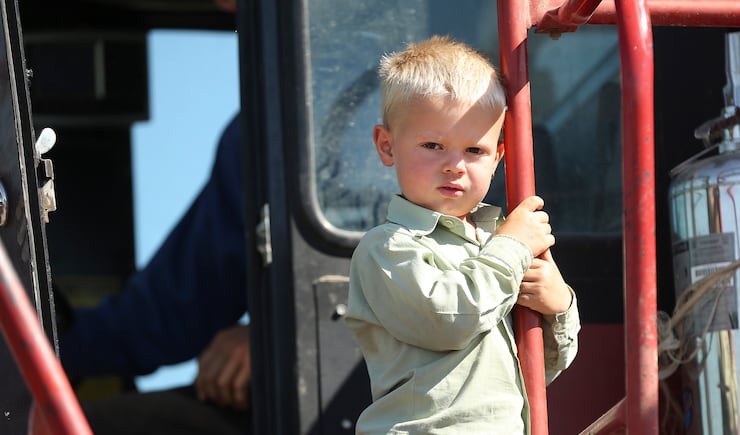

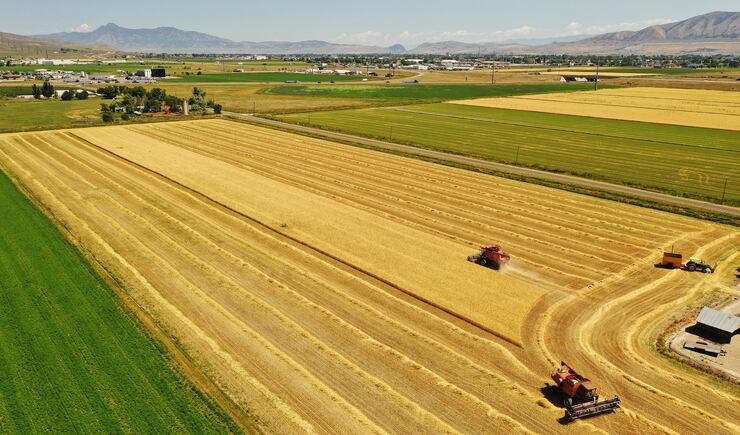

In sacred text
Patrick Mason, a professor of history and religion at Utah State University, will be the first to admit he has no special horticultural knowledge or skills. “I struggle to keep a garden alive,” he said. “I get all my food from a store.”
But even as a “person removed from nature” in terms of growing food, the professor can still relate to and understand the New Testament parables of the mustard seed, the sower and others. Mason said he drew upon principles of faith as taught in the Book of Mormon’s Alma Chapter 32 when writing his 2015 book, “Planted: Belief and Belonging in an Age of Doubt.”
“They are so universally accessible,” Mason said. “Even if I’m not a farmer, I can appreciate the basics of what it means to plant a seed in good soil, nurture and cultivate it. All of us can connect to it on some basic level. I think that’s the brilliance of that language. ... I think all of that agricultural language is inviting us back into a time when humans were more connected to the land than most of us are now.”
These universal principles extend beyond Christian scripture. Virtually every religion has sacred text with language about nature, trees, gardens, animals and vineyards, partly as a celebration of God’s creation of the world, the cosmos and humanity’s place in that, Mason said.
“Where did Buddha find enlightenment? Sitting under a tree. Similar things are found in Hinduism. ... Native American and indigenous spiritualities are deeply connected to the land and nature,” he said.
During the COVID-19 pandemic, Mason has observed people recognizing the importance of growing and preserving their own food. Not only is it wise to be prepared for hard times, but keeping a garden can be therapeutic.
“To distance ourselves from nature and from natural processes, maybe when nature invites us back and maybe when we go back and get our hands dirty, and realize what it means to grow and harvest something, maybe we also relearn what it means to be human, too,” Mason said.


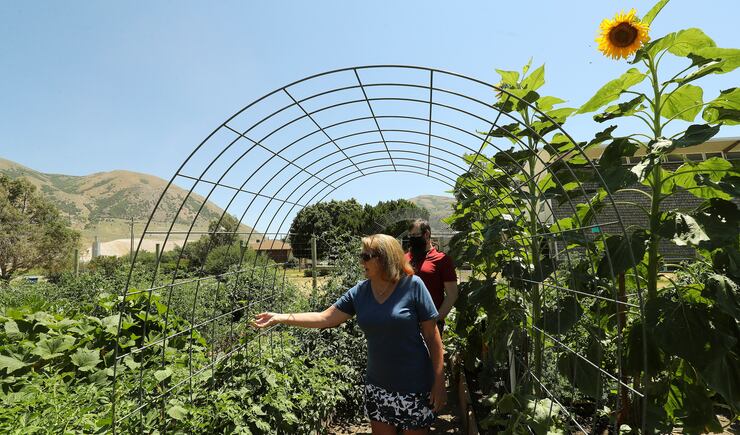
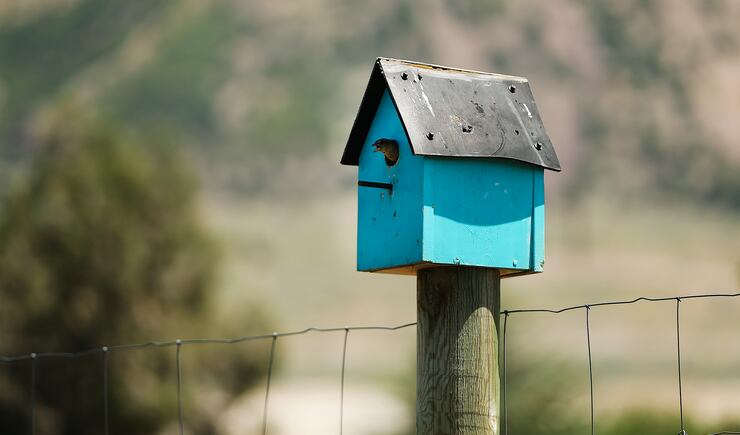
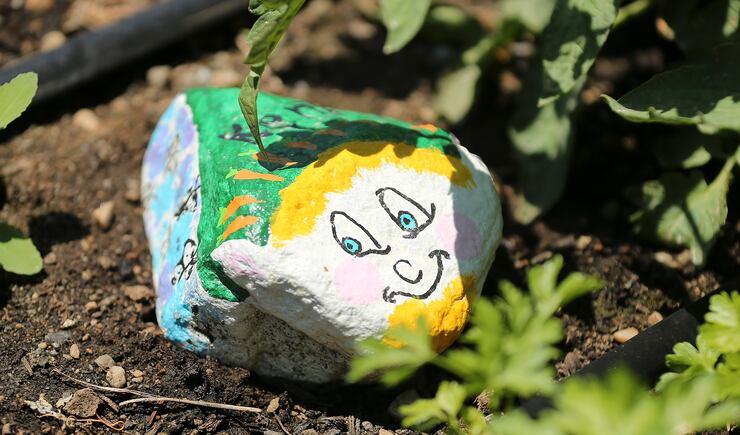

‘Gift’ of a community garden
For many years, Pastor Michael Galica said Brigham City’s Holy Cross Lutheran Church was identified by its architectural design, which wasn’t flattering.
“For a long time we were known as the ‘toaster church’ because the building vaguely resembles a toaster,” Pastor Galica said. “Now when you talk to people it’s the ‘church with the garden.’”
The transformation started more than six years ago when Jenny Hill, a lifelong member of the congregation, lost her father. Hill explained that when a person dies, it’s customary for the family to give a memorial “gift” to the church. Her initial idea was to clean up a part of the church’s property covered in weeds.
“The whole gardening experience teaches you responsibility, respect for others and the earth. It’s a great way to grow.” — Jenny Hill
Then an ambitious friend suggested a bigger idea — the development of a community garden. She accepted the challenge and became a volunteer administrator. Looking back, Hill said the project was inspired.
“I didn’t plan my retirement to do this. I had no visions of doing anything like this in my life,” said Hill, a retired registered nurse. “This was a God thing ... and the response was dramatic.”
With the church’s permission, Hill and others began cleaning up weeds in the space next to the building in 2014. Six years later, visitors can walk through a gate into a green and fertile maze of organized garden boxes alive with all kinds of vegetables and plants, along with a pavilion, picnic tables and a greenhouse. A long list of community partners, sponsors, organizations and volunteers have contributed to the garden’s success.
For a fee of $15, individuals and families can take stewardship of a plot in the Box Elder Community Garden and grow fresh produce. Last year more than 3,600 pounds of fresh produce from the community garden was donated to local food pantries, Hill said.
Hill talked about the joy and benefits of gardening that came to a disabled Vietnam veteran and a 91-year-old woman who delighted in working the soil. Now there is a waiting list to get a plot, along with plans to expand the garden in the coming years.
To see how far the project has progressed over the last six years — the fruits of their labor — has been gratifying for both Hill and Pastor Galica.
“For us, the fruit of this garden is an obvious representation of the fruit that we have from our faith. We believe that a big component of our faith is loving our neighbor,” the pastor said. “And it sure makes me feel better when I write my sermon to look out on the garden from my office window. ... Now we’re known for the garden and growing food for the needy.”
The harvest is just one step in the process, but “what a feeling,” Hill said.
“The whole gardening experience teaches you responsibility, respect for others and the earth,” she said. “It’s a great way to grow.”
Blessings of agriculture
As a seasoned agricultural specialist, Sperry has worked on Latter-day Saint projects all over the world. In managing all of the church’s welfare farms and ranches, which produce large amounts of vegetables, crops, fruit and livestock, everything he does revolves around lessons from the law of the harvest. His parents taught him to appreciate those scriptural lessons as a young man.
“When you are an agricultural specialist, a farmer or rancher, you put so much trust in the Lord that he’s going to help you take care of your family and your neighbors with crops. Most of the time he blesses quite abundantly,” Sperry said. “To me that is heavily intertwined with not only taking care of oneself, but also watching out for and caring for your neighbor and those in need.”

In recent months, with a pandemic and millions of American out of work, the church has given aid to the needy through more than 630 projects in over 130 countries. President Russell M. Nelson called the effort the largest-ever humanitarian project of the church.
For that reason, it’s essential that agriculture carry on, he said.
Over years of travel, Sperry has observed that people who get outside and work in the earth are naturally happier. He recalled working in Ethiopia during a couple of different famines when conditions were dire. While some died, others who worked found physical, mental and spiritual endurance.
While developing garden projects in places like Mexico City and São Paulo, and even in Cape Verde, off the coast of West Africa, where soil had to be imported, Sperry said people who were willing to go out and put a little bit of soil into a little container on their balcony saw the world in a different light.
“You’re out, you’re working in the soil, you’re getting sunshine, and you’re doing something that I think encourages faith,” Sperry said. “And anytime you exercise faith, I think health follows that directly every single time. The exercise of faith, which is what agriculture is, and health care, are intertwined.”

